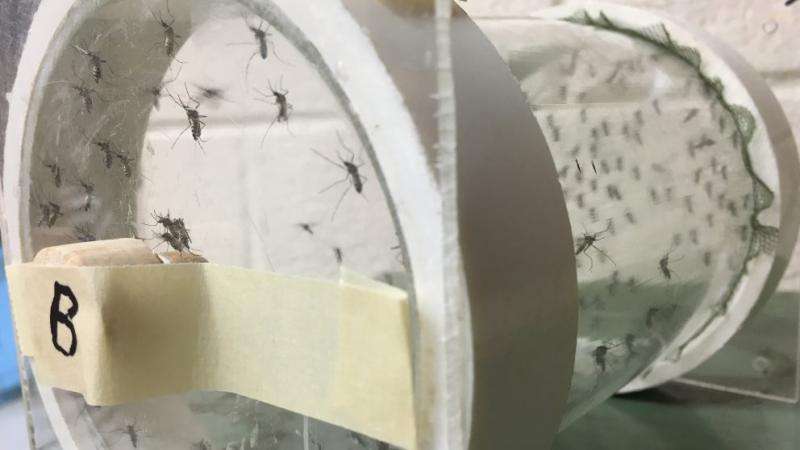A fashionable response to Zika protection

Just down the street from main campus, a research volunteer sits in an enclosed cage with several hundred hungry mosquitoes. When he emerges after 20 minutes, he has sustained just a few bites. The results are strong. His protection? A suit of sleek and breathable fabric. The test is part of NC State's research to develop a highly-engineered, chemical-free, lightweight fabric that is mosquito resistant.
As part of a five-year collaboration between NC State's College of Natural Resources, College of Textiles and College of Agriculture and Life Sciences, researchers are aggressively looking to find solutions to protect people living and working in locations infected with mosquito-borne illnesses.
Marian McCord, associate dean for research in the College of Natural Resources, is leading the effort to develop novel protective clothing.
"Our project brings textile engineers, technologists and designers together with entomologists to study how mosquitoes interact with textile structures, and to use that knowledge to design, prototype and model chemical-free fabrics that provide exceptional comfort and protection from mosquito bites," McCord said.
By transmitting vector-borne diseases, mosquitoes are the deadliest animals on the planet, far surpassing sharks, snakes and even humans in the number of deaths caused per year. With the emergence of the Zika virus and the declaration of a new global health emergency by the World Health Organization, there has been increased attention to the dangers of mosquitoes.
"Now that we know the Zika virus causes severe birth defects and is associated with other adverse health effects, there is even greater need to protect people. This is not just an issue for pregnant women. We need to protect women's partners who can sexually transmit the virus as well. It's also a security issue for our military troops being sent into infected countries, and a workforce issue for employees who are outside in these areas," McCord said.
Zika is transmitted to people through the bite of infected female Aedes aegypti mosquitoes, which are found in all countries of the Americas except Canada and continental Chile. It is believed that the virus will likely reach all countries where Aedes aegypti mosquitoes are found, adding another threat to the hundreds of millions of people who are already at risk of infection with yellow fever, dengue and Chikungunya viruses also transmitted by these mosquitoes.
As of November 2016, 49 countries and territories in the Americas have confirmed local, vector-borne transmission of the Zika virus since 2015. The virus officially made landfall in the continental United State at the end of July 2016 with confirmed cases of locally transmitted Zika in a small neighborhood north of Miami, Florida.
The current recommendation for preventing Zika transmission is to apply DEET or other chemical repellants multiple times throughout the day.
"Exposure to chemical repellants is highly undesirable to large segments of the population, especially pregnant women and children. Economical, accessible and sustainable vector protective clothing that does not use chemicals may be much more appealing for many and would limit the need for repellents to exposed skin," McCord said.
How can a textile prevent mosquitoes from biting?
There are few effective non-chemical mosquito protective clothing options, and often protection comes at the sacrifice of comfort. By developing a non-chemically treated textile, the public will have a new option for protection against mosquitoes that is both comfortable and fashionable.
The fabrics being developed through the collaboration at NC State use fabric structural designs to prevent the mosquito's proboscis from penetrating the fabric.
"We are trying to develop a multitude of fabrics such as undergarments and outer-garments that will suit differing conditions. Fabric properties are developed for the end use. It would be easy to make a fabric bite proof by just laminating the surface, but then the fabric would lose its breathability and comfort," Andre West, assistant professor in the Department of Textile and Apparel, Technology and Management, said.
As part of the collaboration, R. Michael Roe, William Neal Reynolds Distinguished Professor of Entomology, and Charles Apperson, William Neal Reynolds Professor Emeritus of Entomology, raise and maintain colonies of mosquitoes and conduct four tiers of textile testing covering the range from small fabric swatches to whole garments. Along with their technician, John Strider, they have developed a new in-vitro assay system that allows rapid screening of prototype textiles.
These highly-engineered fabrics come in a variety of designs and are breathable, effective and conducive to fashionable clothing. The first garment will likely include leggings and a fitted top, as well as a billowy hip length cardigan.
"These fabrics are designed to prevent the mosquito from penetrating all the way to the skin, but are porous enough to allow air permeability and moisture management," West said. Evaluation of fabric comfort is being performed by Emiel DenHartog, associate professor in Textile Engineering, Chemistry, and Science, in the Textile Protection and Comfort Center in the College of Textiles.
As the testing and design continues, researchers will next begin developing bite-proof fabrics for commercial use within the parameters set by certain end users.
"We continue to improve on the fabric, the garment construction and the garment itself to make products for a multitude of different end uses. There are certain segments of the population that are more susceptible right now, such as pregnant women. We are planning to do more in-cage tests in the future to get as close as possible to a bite-proof fabric that has the performance characteristics desired," West said.
To take this ground-breaking research from the lab to market, the team has worked closely with the Office of Technology Commercialization and New Ventures (OTCNV) to identify commercialization opportunities and file a patent application. To date, the team has executed a license agreement and a follow-on research agreement with one company. The OTCNV is continuing discussions with other industry partners to maximize the commercial potential of the technology and to provide new options for protection against the Zika virus for millions of individuals in high-risk areas.


















